
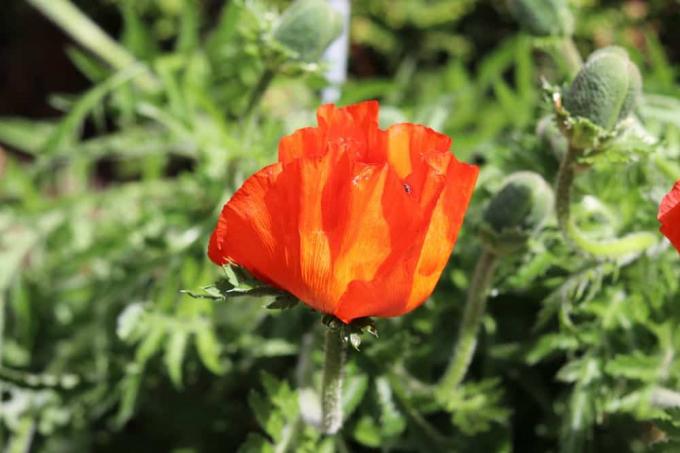
Table of contents
- Is the Turkish poppy hardy?
- Turkish poppy in winter
- winter preparations
- Withered flowers
- plant supports
- remove green
- Set up winter protection
- Winter hardiness in young plants
- propagation during winter
- Overwinter in the pot
- after winter
Poppy plants are a welcome guest in the garden because of their striking flowers. The Turkish poppy, also known as the oriental poppy, comes in a variety of shades ranging from red to yellow to white. Like many other poppy varieties, Papaver orientale is hardy and will withstand even extremely cold winters if the plant has been properly cared for over the past year.
Is the Turkish poppy hardy?
The Turkish poppy, Papaver orientale, is a type of poppy plant that comes from the western part of the Near East. As the name suggests, it comes from Turkey and is also native to Iran and the Caucasus. Due to its natural range at the foot of mountains, it is necessary for the plant to endure cool temperatures and snow. The fire poppy thrives over the summer due to the numerous hours of sunshine, which enable the plant to grow robustly.
If the growth of the Turkish poppy is not disturbed, it can easily be brought through the winter if certain conditions are met. Newly planted poppies can easily survive the winter if the seeds are planted at the right time. Turkish poppy has a hardiness of climate zones 3 to 8a, which makes the plant a enduring crop even in colder regions.
Turkish poppy in winter
Compared to other poppy species such as the local corn poppy, Papaver orientale is one Perennial perennial that is particularly long-lived and for this reason can be found in many perennial beds can be found. Like other perennials, the upper part of the poppy, i.e. the leaves, flowers and shoots, dies off almost completely and it only the roots with the taproot and part of the green remain, which sprout in the following spring becomes. This bit of green remains throughout the winter and the plant grows in width from year to year, which illustrates the growth of the perennial.
Tip:
Each color variant of Papaver orientale behaves the same over the winter. Therefore, you don't have to worry if your Turkish poppy with white or salmon pink flowers is all its greenery loses, because this will return in the spring and with proper care to a true splendor for which the poppy is known is.
winter preparations
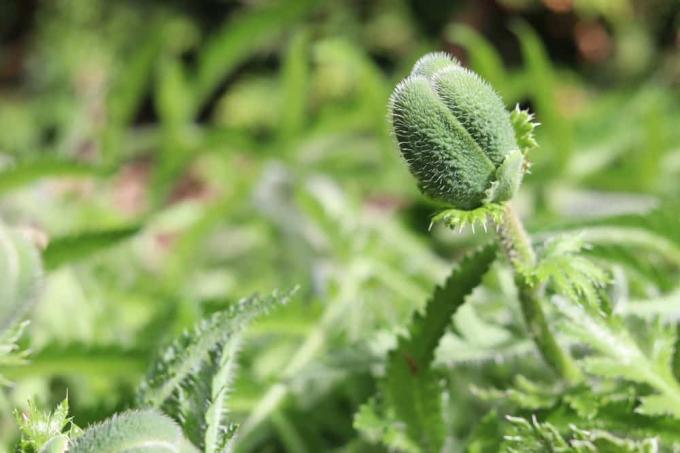
In order to get the garden poppy through the winter, preparation in autumn and care in summer and spring are particularly important. These enable the poppy to grow vigorously, which helps the plant to survive in winter. Since it can withstand temperatures as low as -40°C and loses all its greenery during the winter, the root in particular needs to be prepared. The most important point is the location you have chosen for your poppies. This must generally have good drainage, otherwise the roots will rot, since Turkish poppy does not tolerate waterlogging at all and can die very quickly. You should therefore place your poppies on permeable soil so that they are not drowned by the first thawing water in spring. In addition to the location, you should take care of the following points:
- Withered flowers
- plant supports
- remove green
- Set up winter protection
Tip:
If you have a particularly old specimen that has had several winters, you can completely do without winter protection. Oriental poppy is so robust that it no longer needs protection as it gets older, but it should be protected with it for the first few years.
Withered flowers
Unlike other plants, the Turkish poppy does not have to be freed from withered flowers. Since the poppy is treated with a pruning in between, especially in early summer, no pruning is required before the onset of winter. Even if the poppy still has residual flowers that have withered over time, you can simply leave them on the plant. Pruning at this time could injure the important greenery necessary for spring budding. Because it's rare for poppy flowers to remain present until the end of fall, many gardeners are confused as to whether to prune them. However, due to the behavior of the poppy, this is really not necessary.
Tip:
Listen carefully when dried flowers can be found on your Turkish poppy. As the flowers have withered, the characteristic clicking sound of the dried seeds still in bloom can be heard.
plant supports
The older the Turkish poppy gets, the taller it grows over the year. Despite its robustness, it can easily be twisted by strong winds, people and animals. For this reason, the plant always needs supports to avoid buckling. Since the poppies completely retire over the winter, you can remove the supports and put them back in the bed in spring when the oriental poppies show up again. This is especially recommended for supports that could rot or rust due to the moisture in winter. In this way, you can also specify a growth direction for the poppy in the following year, according to which it can orientate itself.
remove green
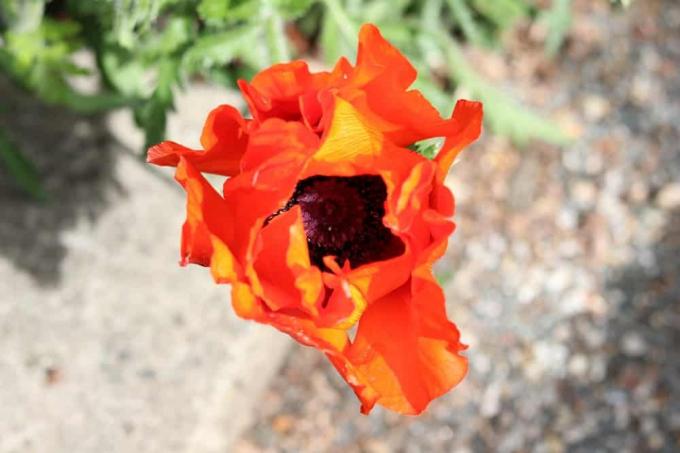
Before you can set up the important winter protection, you have to remove the previous green that the poppy has shed. To do this, simply run your hand over the sprouts of the poppy seed and any that have already dried will fall off very easily. After that, collect any greens that are on the ground so the soil is free for winter protection.
Set up winter protection
Despite their insensitivity to cold, it is advisable to set up winter protection for the Turkish poppy. The best time for this is mid-autumn, since from this point onwards more and more green will dry up and recede. A small layer of different materials that can be used as mulch is sufficient for the plant. Best suited for this is mulch made of the following substances:
- brushwood
- straw
- leaves
Mulching helps the plant stay warm in winter, which is especially recommended for young plants in their first year, and provides nutrients to the poppy. Since the fire poppy is rarely fertilized, mulching is particularly good as winter protection, as the nutrients can be easily absorbed by the roots. They support the root in its function of getting the plant through the winter. The plant materials listed above make very good mulch as they rot easily, but not too quickly. So they can be used effectively for the cold season without being too heavy on the roots. The mulch is distributed as follows:
- Prepare the mulch. That means they take, for example, a large pile of leaves that have accumulated over the fall and move them near your poppy plants. This should not have rotted already, as this happens over the winter.
- After clearing the Turkish poppy site of remaining greenery, spread the mulch around the plant in one layer. This should be tight, but does not have to be high. It should have no open spots and act like a blanket to keep the root insulated.
- Insulate the root area especially well, as this part of the plant is the most sensitive. All you have to do is use a little more mulch and coat the part of the plant that sticks out of the ground extra well.
- Now you can simply leave the plant over the winter and continue to take care of it in the winter.
Winter hardiness in young plants
Turkish poppy is an easy-care plant that is easy to grow in the garden and even overwinters in the first year without any problems. Although it is not as frost hardy as older specimens, for example because its taproot is not as pronounced, it can survive in the garden without hesitation. You don't even have to reach into your bag of tricks for this, just follow the points above and use a little more winter protection for the still young roots.
propagation during winter

When the poppy gets too big, many gardeners tend to propagate the plant, which is a really easy thing to do with the Turkish poppy. It is even possible to propagate the plant during the winter period, paying attention to certain points so that the plant does not suffer from the division. Since the Turkish poppy is very robust and forms a large number of roots next to the actual taproot, these are easy to reach and can be removed without damaging the plant.
The root cuttings do not reduce the plant's hardiness and are a good way to ensure new specimens without having to sow seeds. The advantage of dividing over the winter is that you don't have to wait for seeds to form or do a large-scale division that can't be done until spring. Root cuttings are obtained as follows:
- Carefully examine the roots of the plant and pick out one or two fairly young roots. Never cut the taproot or the entire plant will suffer.
- Take a sharp, clean knife and cut off the cutting. You should be careful not to crush the roots and for this reason scissors should not be used.
- If there are any growths, remove them.
- Place the cutting in a pot with substrate suitable for poppies and keep the plant indoors until spring.
- After shoots have formed, the poppy can be planted in the garden at the beginning of spring. Be sure to plant the plant in the same soil as the Turkish poppy does not tolerate being transplanted very well.
Overwinter in the pot
If you grow young plants in pots and put them in the garden too late, it is advisable to grow them indoors or in the conservatory. Young poppy plants should always be planted in spring so that their roots can attach themselves to the soil location and if this is neglected, the plant must be in the pot until next spring remain.
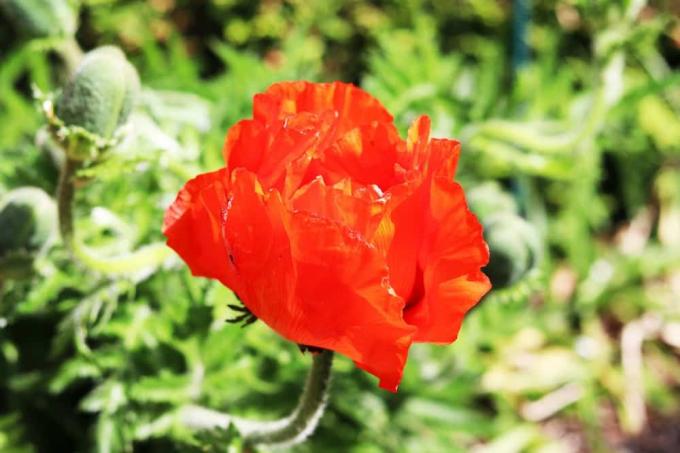
During a winter in the pot, make sure not to store the poppy too warm so that it can rest. Don't overwater it and do without fertilizer, the taproot would not stand it. Choose a spacious pot for the poppy so that the plant does not lack space. Pots that are higher are well suited for this. Ideally, take a compostable pot that you can plant together with the plant from spring.
after winter
As soon as winter is over and spring has arrived, the winter protection from the previous year should definitely be removed. Since this can become soaked with water due to the warm temperatures if it is not completely rotted, it becomes a danger for the poppies. It is very sensitive to excess moisture. After you have removed the winter protection, you can proceed with the spring care as usual.
Tip:
You can use fresh compost as frost protection if you are afraid of late frosts. To do this, simply spread a small amount of compost where you previously removed the winter protection.
 garden editorial
garden editorial I write about everything that interests me in my garden.
Learn more about flowers
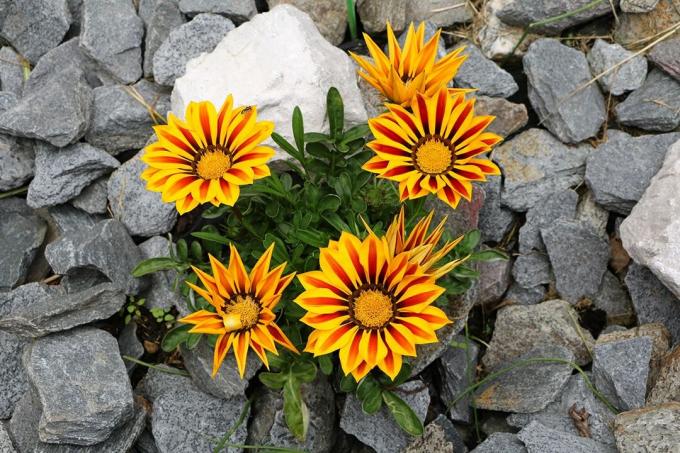
Midday gold, Gazania: proper care and wintering
The midday gold, which impresses with its colorful and sun-loving flowers, is one of the most popular perennials for local gardeners. The right tips for caring for and overwintering the Gazania have been put together for you here.

Caring for, overwintering and cutting asters | Instructions
The radiant flowers of the asters enchant every garden as well as in pots, terraces and balconies, depending on the variety, from May until well into autumn. Caring for the perennials is not that difficult if everything is known about wintering and cutting.

Magnificent pier, Astilbe: care instructions from A - Z
Astilbe is very popular in the garden. Still, gardeners need to consider a few things if they want the plants to thrive. In our A-Z care instructions, you will learn everything you need to know about the splendor, from flowering to winter protection.

California Poppy, Eschscholzia californica: Care Instructions
Hardly any garden plant is as easy to care for as Californian poppy (Eschscholzia californica), which, with its golden yellow flowers, is a feast for the eyes in the home garden. In order to ensure the bright sea of flowers, a few points should be considered with regard to care.

17 hardy bee-friendly flowers
There has been talk of bee deaths for years. You absolutely need help to survive. Bees are an important part of our ecosystem. Garden owners can also help the small insects with the design of their green oasis.
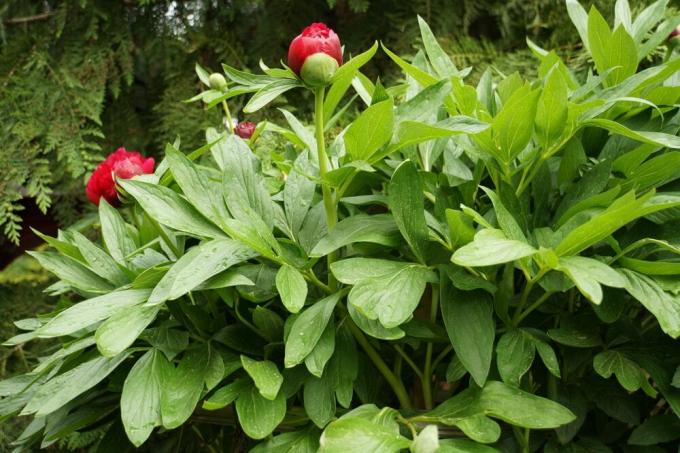
When do peonies bloom? | Beginning and duration of the flowering period
Peonies are garden perennials that, after a few years, form a veritable sea of flowers in early summer. The individual flowers are long-lasting and are also suitable for cutting. Depending on the variety, they bloom in different colors. But when exactly is the heyday?
